If you’re wondering what to look for when buying windows, consider everything windows do for your house. They provide natural light, outside views, insulation and security. The best windows for any home will provide all of these benefits while blocking out wind drafts and UV rays. A window must also be fully functional and easy to open and close properly with no physical strain on your part.
How to Choose Replacement Windows for Your Home
Many variables will affect your decision on what kind of windows to get. The following window buying guide covers key factors you should consider and what to look for when buying replacement windows.
1. Framing Material
When it comes to choosing windows for your home, the first decision to make is which frame material would be the right fit for your needs. There are many factors to consider with each material, such as the durability, appearance and insulation qualities. Overall, you have four framing materials to choose from when you select a set of windows:

- Wood: Some of the best windows for home installations are made with wooden frames, which provide a natural look most homeowners prefer. As a natural material that has been used in architecture for centuries, wood frames provide insulation and usually last through several generations of occupants at a given property. You can either paint or varnish wood, therefore making it applicable to a wide array of color schemes and interior styles.
- Fiberglass: One of the newer options on the market for window frames is fiberglass, which is a strong and visually diverse material. Many modern homeowners favor fiberglass because of its ability to mimic the appearance of other materials, including wood. Frames made of fiberglass are weather-resistant and generally offer good insulation in a variety of climates. Unlike wood, fiberglass does not need to be painted or coated, and the material retains its original color.
- Vinyl: Homeowners who favor a sleek, shiny look for their window frames often choose vinyl, which is typically seen around the window panes of newer homes and buildings. As with fiberglass, vinyl does not need to be painted, coated or maintained in any way. Many residents also favor vinyl due to its insulating qualities, which allow them to save on energy. However, vinyl is known to fade over time through direct exposure to sunlight.
- Aluminum: For many decades, window frames made of aluminum were almost as popular as wooden ones. However, while wood remains a perennial favorite, aluminum has mostly fallen out of favor amid the rise of fiberglass and vinyl. The problem with aluminum is that it provides poor insulation and can leave homes exceedingly cold in the winter months. Today, aluminum window frames are mostly used in apartment complexes and business buildings.
Ultimately, your choice in a frame material could depend on the age and design of your home. If you live in an older house with a classic architectural scheme, wood would probably be the most appropriate option. If your home was built within that past two decades, fiberglass or vinyl might be the more aesthetically suitable choices.
What Kind of ReplacementWindows Should I Get For My House?
2. Style
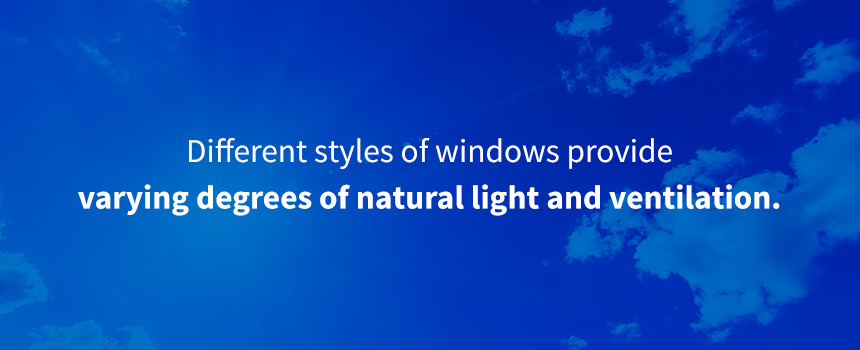
The next step is determining what to look for in a replacement window. The style of the window should be considered before buying. Different styles of windows provide varying degrees of natural light and ventilation. Overall, windows come in styles that slide either vertically or horizontally, or that tilt outward from the top, bottom or side. Typical options include:

Single-Hung: Single-hung windows consist of two horizontal sashes, with or without grilles. The bottom sash opens while the upper sash remains fixed. To open the window, the bottom sash is raised internally in front of the upper sash.
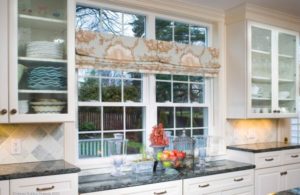
Double-Hung: Double-hung windows also consist of two horizontal sashes, with or without grilles, and both sashes open. The lower sash is raised internally in front of the upper sash, while the upper sash lowers externally in front of the lower sash.
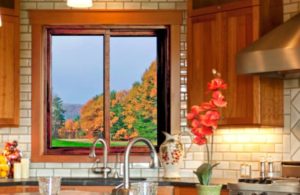
Sliding: Sliding windows consist of two and sometimes three vertical sashes. The sash that opens moves from side to side, rather than up or down. In sets with two sashes, the right sash opens leftward internally in front of the stationary left sash. In sets with three sashes, the two end sashes may open in front of the stationary center sash.
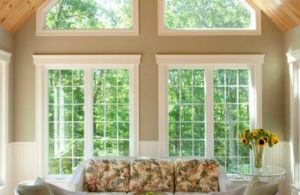
Casement: Casement sets consist of one vertical window, with or without grilles, that slides outward at one end. The window can be cracked slightly for minor drafts or opened out to 45-degree angles for more ventilation. Casement windows open with a crank handle, which you can turn until you’ve reached the desired openness.
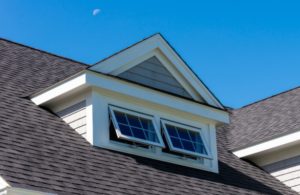
Awning: An awning consists of a horizontal window that opens outward along the bottom. The awning is hinged along the top frame. Awnings are often above vertical windows for added ventilation.
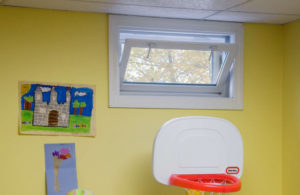
Hopper: A hopper is basically the reverse of an awning since it opens inward along the top. The hopper is hinged along the bottom frame. As with awnings, hoppers provide added ventilation when situated above vertical windows of the sliding or casement variety.
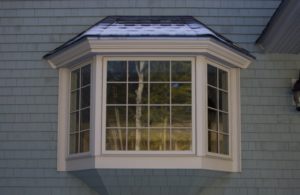
Bay: The bay window is a protruding set that consists of three horizontal windows, each with or without grilles. The two side windows protrude from the exterior of the house at 45-degree angles while the center window aligns parallel to the wall, effectively forming a half-relieved hexagon. The side windows open to an outward tilt with the use of a crank handle, while the center window remains stationary. Bay windows create extra interior space, which homeowners often use for plants, candles and fixtures.

Bow: The bow window is much like the bay, only rounded. A bow assembly will typically consist of four or five horizontal windows to achieve the more oval shape. The two outer windows are usually equipped to open outward. As with the bay window, the bow protrudes outward from a home’s exterior and creates additional interior space.
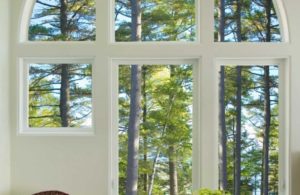
Fixed: A fixed window is one that does not open. Most fixed windows are decorative, such as the round, triangular or rectangular windows that are sometimes seen above doors and regular window sets. Fixed windows are generally used for additional natural light and are most common in homes with high ceilings.
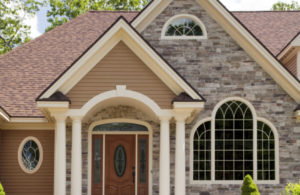
Custom: Some homeowners opt to have their windows custom made. If you have unique design ideas and are willing to invest, you could have a window that combines several styles into one.
For most homeowners, hung and sliding windows are the most popular options. However, a window that opens and closes with a crank handle will generally offer a more air-tight seal. If your home’s exterior is not surrounded by direct foot traffic and prohibitive objects, an outward tilting or protruding window could be the best choice. Learn more below about the styles of windows in comparison to one another.
What Kind of Windows Do I Have?
If the windows in your house slide up or down to open, you have single- or double-hung windows. If you are comfortable with the action required to open and shut these windows, then you might do best with replacement windows in the same style. Granted, you might prefer the functions of a sliding window or even one of the crank handle-operated tilting styles. For older homeowners, the latter will generally require the least amount of physical exertion.
3. Energy Efficiency
The best windows for home use are designed to block the passage of air between the outside and a home’s interior. This way, your house remains more comfortable throughout the hot and cold seasons each year. When heat waves strike, the right kind of windows will help block out heat and insulate coolness. When wind, snow and subzero temperatures strike, solid windows help seal in warmth and prevent the passage of outdoor coolness.

If your energy bills have gradually increased in recent months, the problem could easily be due in part to your windows. If you notice drafts coming in from somewhere along the edges of a window pane or frame, the chances are that a gap has formed due to age, as well as numerous expansion and contraction cycles. A solid set of windows will trap heat inside in the winter months and block out excess heat in the summertime.
Today’s energy-efficient windows are made with two panes of glass. Between the two panes, the window is treated with Argon, a transparent low-e coating that protects glass and helps block out unwanted temperatures. Windows with a low U-factor are best at blocking out winter coldness. Windows with a low solar heat gain coefficient rating are better at blocking sunlight from a home’s interior.
What Kind of Windows Do I Need?
Aside from the physical and stylistic aspects of a window, there is also the climate factor. If you live in an area where summers are exceedingly hot, your house should have windows that can block as much external heat as possible. Likewise, if winter months are exceptionally cold in your area, you should be most concerned with protecting your interior warmth.
4. Ease of Use
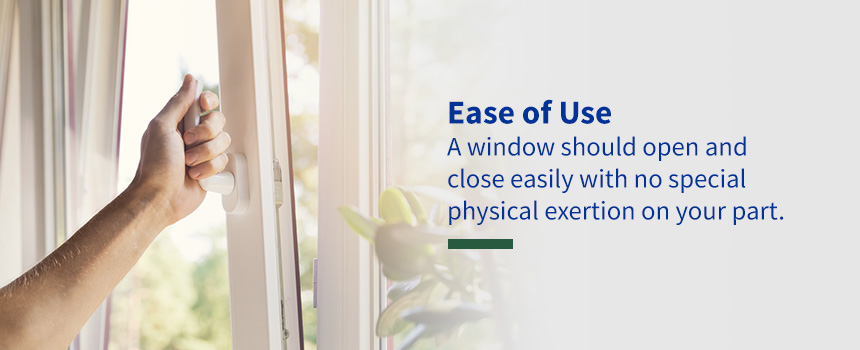
Of the many things to look for when buying windows, one of the most important factors to consider is ease of use. A window should open and close easily with no special physical exertion on your part. Over time, a window can become more difficult to open and close due to the expansion and contraction of the frames, which is caused by changes in seasonal temperature. Therefore, it is essential to have a window that is best equipped to resist these effects.
In some older homes with wooden window frames, the windows are painted shut and therefore impossible to open. This can often be seen in the older communities along the east coast. The trouble is, painted-shut windows could leave you in grave danger if you ever find yourself in a situation where you might need a window to escape your house, such as during a fire.
Windows can also become less operable due to wear. On wooden frames, the wood can become stripped from prolonged exposure to mites and the elements. Newer wooden frames are often coated with aluminum to protect against mold and other corrosive effects, yet wood requires periodic upkeep to prevent it from giving way as the years pass. For wood frames to remain optimal throughout your time at an address, you must have the wood inspected after each harsh season and recoated if necessary.
5. Cost
Many factors affect the cost of a new window. To anticipate how much you are likely to pay, consider the quality, type and size of the window you have in mind:
- Brand: One factor that will somewhat determine the amount you are liable to pay for a new set of windows is the brand of the window. Some brands are known for their exceptionally high quality and therefore sell for higher prices than competing brands. Brands that outsource their labor, such as those that have their products mass assembled in the Third World, will typically sell for less.
- Quality: Another factor that will affect the cost of a window is the quality. If a window line has been tested for durability against a range of temperatures, impacts and water exposure, it is bound to be a more reliable product than a window that fares poorly in such tests. Understandably, windows that demonstrate water resistance, air-tightness and a general ability to withstand the elements are ranked high by installers and customers.
- Material: The material used in a window will also affect its price. Generally, windows made with wooden frames are priced higher than their fiberglass and vinyl counterparts, which in turn cost more than most aluminum-framed windows. With the exception of aluminum, however, the main framing materials each have advantages and are equally strong and durable. That said, wood is often considered the classiest option and is therefore perceived as being of higher value. Expect to pay twice as much for a wood-framed window than you would for a vinyl one.
- Dimensions: Size is another factor that will help determine the price of a window, as larger windows require more glass and framing materials than their smaller counterparts. Bay and bow windows, for example, will cost more than awnings and hoppers. Windows that consist of a single fixed pane will generally cost less than hung and sliding windows.
When Is the Best Time to Buy and Replace Windows?
The short answer is, whenever you’re ready to see the benefits of energy-efficient window installations for your home!
It is impossible to predict the exact life span of your current windows. Whether you notice cold or warm air entering a room, window glass that’s damaged, or you want to give your home an aesthetic upgrade, the right time to replace windows is up to you.
You can replace windows year-round — however, it can be more challenging for installers during months that are wet and cold and leave fewer daylight hours to work. That said, it’s worth exploring the pros and cons of replacing windows in spring and summer vs. fall and winter.
Spring and Summer
Spring is a natural time for homeowners to investigate which parts of their house require attention. Many homeowners prefer to get new windows during spring since temperatures are mild, putting less strain on heating and cooling systems while the work is being done. Note that springtime can bring rain, so you’ll have to stay flexible in the wake of changing weather conditions.
Installing windows during summer is beneficial due to the warmer weather, but be aware that some installers can get booked far in advance during the summer months. Summertime is also when certain pests are most active — if you’re having windows replaced during summer, take extra precautions to avoid unwanted intruders during the installation time.
Overall, spring and summer are popular times of the year for window installation services. Make sure to book a reliable team as far in advance as possible to secure a spot.
Fall and Winter
Replacing your windows during the cooler months comes with its own advantages. Scheduling an installation throughout fall and winter can leave opportunities for cost savings — some installation companies offer promotions during slow seasons when availability is wide and inventory is plentiful.
During the winter, installers can take steps to keep cold air and winter weather out of your home while your windows are replaced. Crews may fix tarps along openings throughout your space or install one new replacement window at a time. Window installations often take longer during fall and winter, but the potential savings and scheduling flexibility can be worth it.
Buy the Best Replacement Windows for Your Home
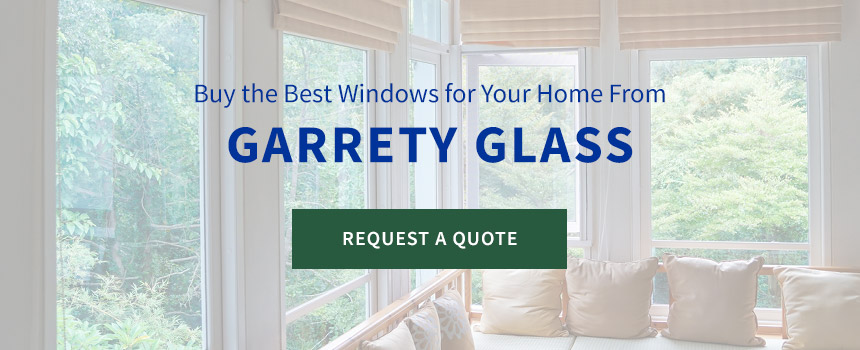
Windows are one of the most important features on any home. As the feature that allows natural light into the house and also offers views of the outside from within, windows make interiors seem less dark, unnatural and confining. At the same time, windows provide insulation and security by blocking out wind, UV rays, insects and intruders.
When you take into account all the benefits of buying new windows for your home, you realize they’re integral to the comfort, convenience and safety of a home. Adding quality shades such as solar, cellular, or roller to your windows can offer additional benefits. As such, top-quality windows are a vital investment. At Garrety Glass, we sell replacement windows to homeowners in central Pennsylvania.
For the protection of your property and the comfort of your household, you owe it to yourself as a homeowner to have the best windows on your home that money could buy. Contact Garrety Glass today to request a quote on our windows and services.